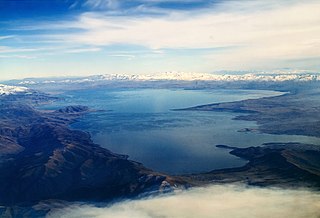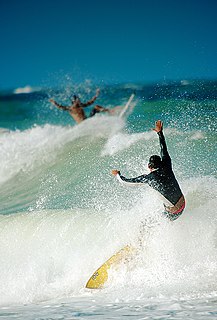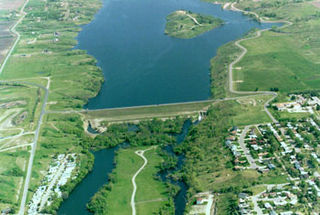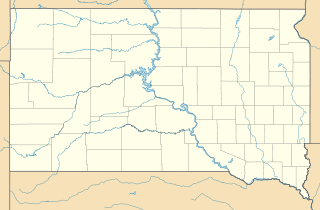| Lake Henry | |
|---|---|
| Location | Bon Homme County, South Dakota, United States |
| Coordinates | 43°08′35″N97°42′05″W / 43.1431319°N 97.7014388°W Coordinates: 43°08′35″N97°42′05″W / 43.1431319°N 97.7014388°W |
| Lake type | Reservoir |
| Primary inflows | Dawson Creek |
| Primary outflows | Dawson Creek |
| Basin countries | United States |
| Surface area | 113 acres (46 ha) |
| Average depth | 6.6 ft (2.0 m) [1] |
| Shore length1 | 7 mi (11 km) |
| Surface elevation | 1,290 ft (390 m) msl |
| References | U.S. Geological Survey Geographic Names Information System: Lake Henry (Bon Homme County, South Dakota) |
| 1 Shore length is not a well-defined measure. | |
Lake Henry is a small artificial lake formed by the construction of a dam across Dawson Creek (South Dakota) in Bon Homme County, South Dakota, United States, about 0.75 mi (1.21 km) east of the town of Scotland.

A lake is an area filled with water, localized in a basin, that is surrounded by land, apart from any river or other outlet that serves to feed or drain the lake. Lakes lie on land and are not part of the ocean, and therefore are distinct from lagoons, and are also larger and deeper than ponds, though there are no official or scientific definitions. Lakes can be contrasted with rivers or streams, which are usually flowing. Most lakes are fed and drained by rivers and streams.

A dam is a barrier that stops or restricts the flow of water or underground streams. Reservoirs created by dams not only suppress floods but also provide water for activities such as irrigation, human consumption, industrial use, aquaculture, and navigability. Hydropower is often used in conjunction with dams to generate electricity. A dam can also be used to collect water or for storage of water which can be evenly distributed between locations. Dams generally serve the primary purpose of retaining water, while other structures such as floodgates or levees are used to manage or prevent water flow into specific land regions. The earliest known dam is the Jawa Dam in Jordan, dating to 3,000 BC.

Bon Homme County is a county in the U.S. state of South Dakota. As of the 2010 United States Census, the population was 7,070. Its county seat is Tyndall.
The lake is within the James River watershed. The lake was named in honor of State Senator Henry Brown of Bon Homme County. The original dam was constructed in 1937. By the late 1980s, however, decades of erosion had degraded the lake and use had declined considerably. Plans to renovate the lake began in 1991 after extensive damage to the spillway was discovered. In 1994, the dam was breached and the lake drained to allow spillway repairs and the removal of accumulated sediments. The renovation project quickly ground to a halt when funding was withdrawn and the lake remained dry for nearly a decade. In 2002, funding for the project was restored. It was determined more economical to build a new dam rather than rebuild the old one. A new site was chosen ⅜ of a mile downstream and construction began late in 2002. The dam was completed in 2003 and completely filled with water in 2005. [2]

The James River is a tributary of the Missouri River, approximately 710 miles (1,140 km) long, draining an area of 20,653 square miles (53,490 km2) in the U.S. states of North Dakota and South Dakota. About 70 percent of the drainage area is in South Dakota. The river provides the main drainage of the flat lowland area of the Dakotas between the two plateau regions known as the Coteau du Missouri and the Coteau des Prairies. This narrow area was formed by the James lobe of the Laurentide Ice Sheet during the last ice age, and as a consequence the watershed of the river is slender and it has few major tributaries for a river of its length.

A drainage basin is any area of land where precipitation collects and drains off into a common outlet, such as into a river, bay, or other body of water. The drainage basin includes all the surface water from rain runoff, snowmelt, and nearby streams that run downslope towards the shared outlet, as well as the groundwater underneath the earth's surface. Drainage basins connect into other drainage basins at lower elevations in a hierarchical pattern, with smaller sub-drainage basins, which in turn drain into another common outlet.

A spillway is a structure used to provide the controlled release of flows from a dam or levee into a downstream area, typically the riverbed of the dammed river itself. In the United Kingdom, they may be known as overflow channels. Spillways ensure that the water does not overflow and damage or destroy the dam.
The lake is popular for fishing and recreation in the area. The lake is stocked by the South Dakota Department of Game, Fish, and Parks. Fish Species found at Lake Henry include: Largemouth Bass, Yellow Perch, Channel Catfish, Black Crappie, Bluegill, Black Bullhead, Green Sunfish, Hybrid Sunfish, White Sucker, and Carp. There is a boat ramp with dock on southeast corner with public restrooms. There are two handicapped accessible fishing piers. The entire lake is designated a "no wake zone". [2]

Fishing is the activity of trying to catch fish. Fish are normally caught in the wild. Techniques for catching fish include hand gathering, spearing, netting, angling and trapping. “Fishing” may include catching aquatic animals other than fish, such as molluscs, cephalopods, crustaceans, and echinoderms. The term is not normally applied to catching farmed fish, or to aquatic mammals, such as whales where the term whaling is more appropriate. In addition to being caught to be eaten, fish are caught as recreational pastimes. Fishing tournaments are held, and caught fish are sometimes kept as preserved or living trophies. When bioblitzes occur, fish are typically caught, identified, and then released.

Recreation is an activity of leisure, leisure being discretionary time. The "need to do something for recreation" is an essential element of human biology and psychology. Recreational activities are often done for enjoyment, amusement, or pleasure and are considered to be "fun".

Fish stocking is the practice of raising fish in a hatchery and releasing them into a river, lake, or ocean to supplement existing populations or to create a population where none exists. Stocking may be done for the benefit of commercial, recreational, or tribal fishing, but may also be done to restore or increase a population of threatened or endangered fish in a body of water closed to fishing.


















